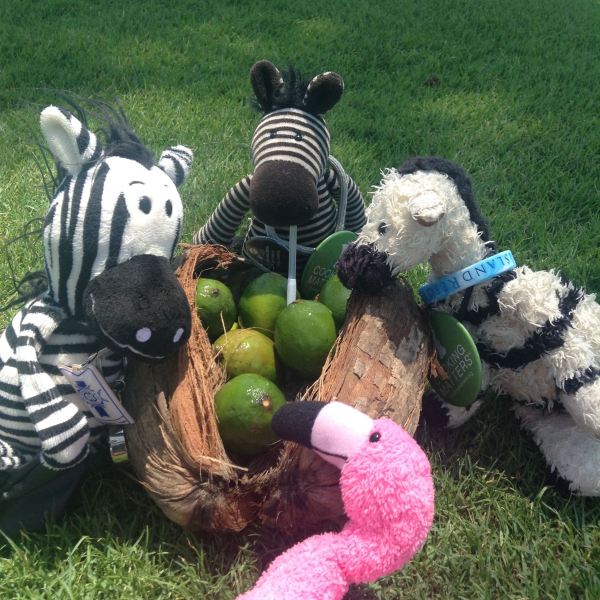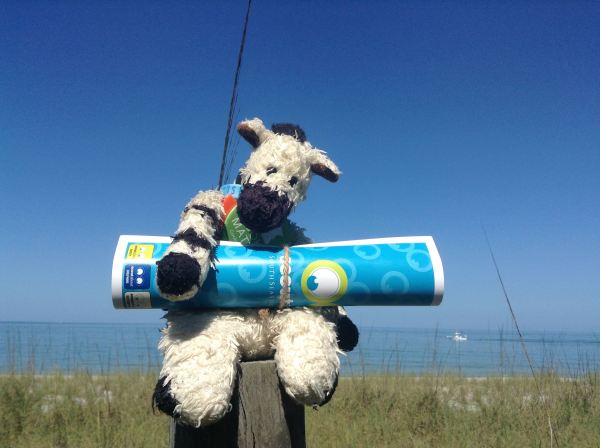When it comes to exploring, zebras (like kids) really know how to earn their stripes!
My Uncle Zep (also known as ZeGreat Chef Zepicure) and I got together to spend a whole month exploring a magical island called Captiva, which is just off the west coast of Florida in ZeGulf of Mexico.
The place where we’ve had our ZHQ (zebra headquarters) is called South Seas Island — which was once a big plantation. In the early 1900s, it was one of the world’s largest growers of Key limes!
We’ve been roaming ZeBeaches and mangrove forests in search of adventure—and an island fruit that could keep us going strong through all our explorations, which tend to make us super hungry and thirsty.
Well, you can imagine how excited we were when we found these big nutty-looking green things underneath a palm tree. We thought it was really cool that they had subtle stripes—and decided to call them ZebraNuts.
We grabbed a couple and hoofed it over to a shady spot for a picnic. However, we soon realized that we had no clue how to open them. We tried stomping on them, throwing them at tree trunks and pretty much everything else we could think of.
Then Uncle Zep had a great idea (as uncles often do). He suggested we ask our island buddy Jade, a super-cool guy from Jamaica, if he knew how to open them.
Guess what: he did! And guess what else: the green things were actually coconuts, not ZebraNuts. We’d only seen the hard-shelled brown coconuts before—but Jade said that these were young coconuts, which are also known as jelly coconuts.
Jade totally got why we were so perplexed by opening them. He said that when he was a kid in Jamaica, he’d wanted to do the same thing. So he watched his favorite adults—and little by little, he learned.
“That’s the same way I learned to cook,” he told us. “I started out by watching my mom, then I took an elective in high school that helped me get to be really good with ingredients and techniques.”
Of course, even if you’re a kid or a zebra who loves to cook, you shouldn’t try open a coconut by yourself—it takes some serious knife skills! As we watched Jade open a coconut, we saw that great technique is something you learn by watching and practicing.
Jade carefully used his long-bladed knife to whack off the top of the coconut, which went happily flying over the sand like a tropical frisbee.
Inside the green coconut was the clear liquid called coconut water (which we’d only seen in stores before). As we sipped the cool, refreshing water, we felt a rush of energy and nutrients that made our stripes tingle.
There’s a Harry Belafonte song about coconut water that says “it gives you lots of iron—it makes you strong like a lion!” Having been chased by a lion or two ourselves, we totally agreed.
After we drank the water, Jade used his knife to carve a perfect little spoon from the coconut shell. He showed us how to scoop the silken white jelly from inside the coconut. It was sweet and creamy—just like ZeBest coconut pudding you can imagine.
Later, we got together with our buddy Phaedrus the flamingo to do a little research (or in our case, ZeSearch) about coconuts.
We found out that a coconut isn’t a nut, but a fruit called a “drupe” (which kinda sounds like something out of a Dr. Seuss book). We wondered about this, as savoring our fresh coconut had made us feel anything BUT droopy.
But it turns out that, according to ZeDictionary, a drupe is “a fleshy fruit with thin skin and a central stone containing the seed.” (Just FYI, mangoes, peaches, cherries, almonds and olives are also drupes.)
So why are coconuts called coco-nuts? Well, it has to with their scientific name, which is cocos nucifera.
Nucifera means “nut-bearing.” And coco (a Spanish word that can refer to a monkey face) came from late 15th century Portuguese explorers, who thought that the hairy brown fruit with its three ‘eyes’ looked like a monkey.
Some of our best friends are monkeys, so Uncle Zep & I thought this was really cool!
We learned that, just like kids and zebras, a coconut is an island voyager. It can float for days or even months, traveling from its home island to one way across the ocean. When the coconut washes up on a faraway beach, it germinates (starts to grow) from one of its ‘eyes.’ And a new coconut grove is born!
Another really cool thing is that every part of the coconut plant is really useful. As we found out, the water is a great source of hydration and nutrients. And coconut fruit, oil and milk give you tons of energy, vitamins and minerals.
My friend Travis, who’s also from Jamaica, told me that when he was a kid, he used to climb the palms to pick fresh coconuts. He said he and his family love cooking with coconut, using it to make all kinds of both sweet and savory dishes. I asked if he could share some photos of his favorite recipes — check them out below!
Coconuts have nourished humans for so many centuries that the coconut palm is often called “the tree of life.” This makes sense, because you can pretty much get everything you need from these trees.
The coconut palm leaves can be woven into baskets or create thatching for huts – and the trunk makes great supports (or boats!).
All around the world, humans use coconut husks for a fiber called coir—great for making everything from ropes and fishnets to brushes and rugs. You can use the shells as cups, bowls and spoons (just the way Uncle Zep and I did) or to craft all kinds of cool artwork (including the cool Zulu coconuts you can get in New Orleans during Mardi Gras).
As you can imagine, all this coconut study was making us hungry and thirsty again — time for a snack!
Since we know that most humans (and zebras) don’t live on islands where coconut palms grow, we decided to create a special island-style refresher we could share with all our friends. We hope you go coconuts over it!
RECIPE: ZeBot’s Captiva Coconut Smoothie
Our coconut refresher is a super-simple combination of coconut water, pineapple, fresh lime juice and a dollop of yogurt and drizzle of honey. You can find organic coconut water (in cartons) at lots of grocery and natural food stores. It’s super-yummy, nutritious and MUCH easier to open than a fresh island coconut.
What you need:
1 cup of coconut water
1 cup of chopped pineapple
1/4 cup of vanilla or plain yogurt
A drizzle of honey (you decide how much—but not TOO much, okay?)
A couple of squeezes of fresh lime juice
A couple of ice cubes (if your blender can handle them and you like frosty drinks)
What you do:
- Carefully put all of your ingredients into a blender container, then make sure the lid’s on really tight so you don’t get smoothie all over your ceiling.
- Ask your favorite adult which setting works best for smoothies, then push the button. You may need to pulse (turn off and on) the blender a few times to get your smoothie super smooth.
- Pour your smoothie into glasses (this recipe makes enough for you and a friend)—and go coconuts!



















Hello, my friend. I’m up in Sanford. Glad you are staying at the South Seas Resort. Do stay in touch. Love, Cathy Catherine Lucas